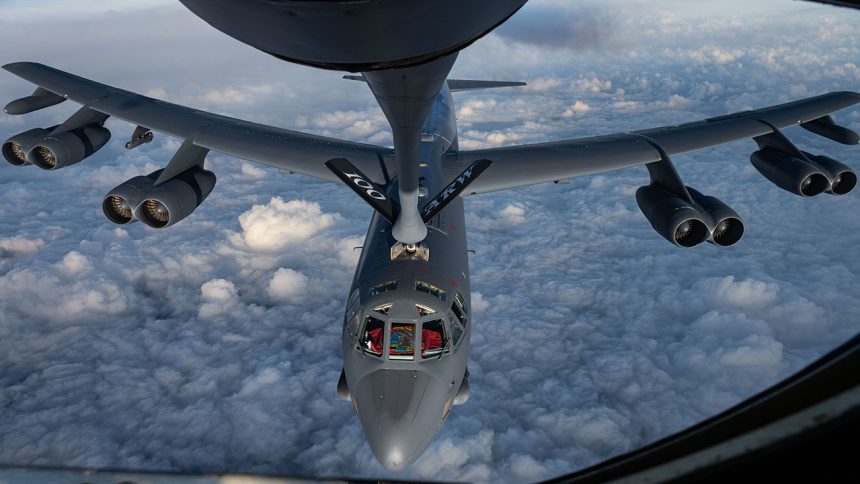The latest round-trip mission was an extension of BTF 24-4 in Europe, which has been a major focus of U.S. strategic operations in the region.
On Sept. 11-12, 2024, two U.S. Air Force B-52 Stratofortress aircraft, flying as MONK 31 and MONK 32, successfully completed what the service described as a “double-transatlantic” mission — essentially a round-trip flight from their home base at Minot Air Force Base, North Dakota, to their destination and back.
According to the U.S. Air Force, the Global Power round-trip mission highlighted the service’s ability to project power and integrate with Allied forces across multiple domains.
The B-52s, belonging to the 5th Bomb Wing, took part in a NATO-led integration exercise in Poland, focusing on multi-domain operations that included contributions from air, land, sea, cyber, and space units. This exercise was part of the broader Bomber Task Force (BTF) 24-4 initiative, which aims to bolster NATO cooperation and deterrence while enhancing the U.S. Air Force’s global strike capabilities.
MONK31 flt (B-52) working GANDER CENTER this evening refueled with FLAM11 flt (KC-46) along the AR62 refueling track over Canada for their Atlantic Ocean crossing. 💪 😎
Audio via @liveatc & tracking via @ADSBex pic.twitter.com/nQgnTUAH6L
— Thenewarea51 (@thenewarea51) September 11, 2024
The aircraft could be tracked online as they flew over Poland and Nordics region.
B-52s x2 MONK31 Flt circling over Poland at the moment, likely a GPM back to the States, but always worth an eye on a possible divert to #RAFFairford pic.twitter.com/Wkqf3BbsQL
— Saint1 (@Saint1Mil) September 11, 2024
At a certain time the BUFFs (from the B-52’s nickname: Big Ugly Fat Fellow), were the most tracked flights on the famous Flightradar24.com website.
Most tracked flights today – MONK31 & MONK32 – two B52’s flying over Europe. pic.twitter.com/Thp83PsaRV
— Flightradar24 (@flightradar24) September 11, 2024
A Multi-Domain NATO-Led Exercise
The Poland-based exercise was a large-scale, coordinated effort that included more than two dozen fighter jets, refueling aircraft, and other support planes from various NATO member nations. The primary goal was to improve interoperability among Allied forces, enhance command and control procedures, and prepare for operating in a contested environment. These kinds of exercises are essential for integrating multi-domain effects, whereby air, land, sea, cyber, and space units work together to achieve coordinated strategic outcomes.
NATO’s emphasis on multi-domain operations reflects the evolving nature of modern warfare, where threats can come from various vectors, including the cyberspace and space-based platforms, alongside traditional land and air domains. By integrating forces across these domains, NATO and its partners can better anticipate, deter, and respond to potential aggression from strategic competitors.
At least two US B-52, #AE3889/MONK31, #AE5890/MONK32 appeared in Sweden before transiting south across the Baltic Sea and taking up a station in northern Poland before RTB.
Poland’s Saab 340 Erieye AEW&C #48D963/PNY598 eventually set up a patrol across the Polish coast. 5/6
— J.S.L.INT (@TheLimpCrane) September 12, 2024
The B-52 Stratofortress played a key role in this exercise, showcasing, once again, its strategic versatility. Known for its long-range strike capabilities, the B-52 is a critical component of the U.S. military’s bomber fleet. It is capable of carrying both nuclear and conventional weapons and has been in service since the 1950s, proving its enduring value in modern combat. The bomber’s participation in NATO-led exercises like this one not only strengthens the readiness of U.S. forces but also builds trust and interoperability with Allies, enhancing collective security.
Reinforcing NATO Partnerships
According to General James Hecker, commander of U.S. Air Forces in Europe – Air Forces Africa, “The successful execution of this NATO-led mission affords us the opportunity to share best practices while also demonstrating our steadfast commitment to Allies.”
Hecker’s remarks highlight the importance of these training missions in promoting unity among NATO members. By training together, Allied forces learn how to operate seamlessly as a cohesive unit, which is essential for responding to shared security challenges. The B-52s’ participation in the NATO exercise not only reassures U.S. partners but also serves as a visible deterrent to potential adversaries who may be considering aggressive actions in Europe.
This mission is part of the larger Bomber Task Force 24-4, a recurring series of operations that allow U.S. strategic bombers to train with NATO and other Allied nations. During BTF deployments in Europe, the strategic bombers engage in joint operations with NATO Allies and other international partners to enhance capabilities and reinforce security commitments within the U.S. European Command’s jurisdiction.
The latest mission was an extension of BTF 24-4 in Europe, which has been a major focus of U.S. strategic operations in the region. Earlier in the summer, two B-52s made history by operating from Mihail Kogălniceanu Air Base in Romania for the first time, further demonstrating the adaptability of U.S. forces to operate from forward locations.
BTF missions have taken place in Europe on a recurring basis since 2018, with the aim of strengthening the U.S.-NATO partnership and demonstrating the ability of the U.S. to deploy its strategic bombers anywhere in the world. These missions are not limited to Europe; the Bomber Task Force also conducts operations under multiple combatant commands, ensuring that U.S. forces remain prepared for a wide range of security challenges across the globe.
Agility and Readiness in Global Strike
The ability of the B-52s to conduct such long-range missions and return to their home base in North Dakota showcases the agility and readiness of U.S. forces. This double-transatlantic mission required careful coordination between the U.S. Air Force, NATO, and several Allied nations, illustrating the depth of planning and operational capability involved in such missions.
While the B-52 Stratofortress has been in service for over six decades, it continues to play a crucial role in U.S. and NATO defense strategies. The aircraft’s longevity is a testament to its robust design and ability to adapt to modern warfare. The B-52 is expected to remain in service for decades to come, continuing to provide long-range strike capabilities that are vital to the U.S. and its Allies.









